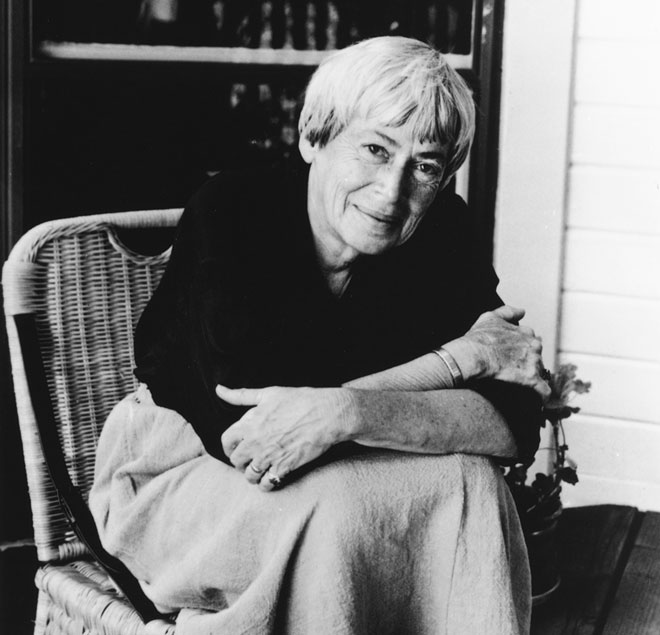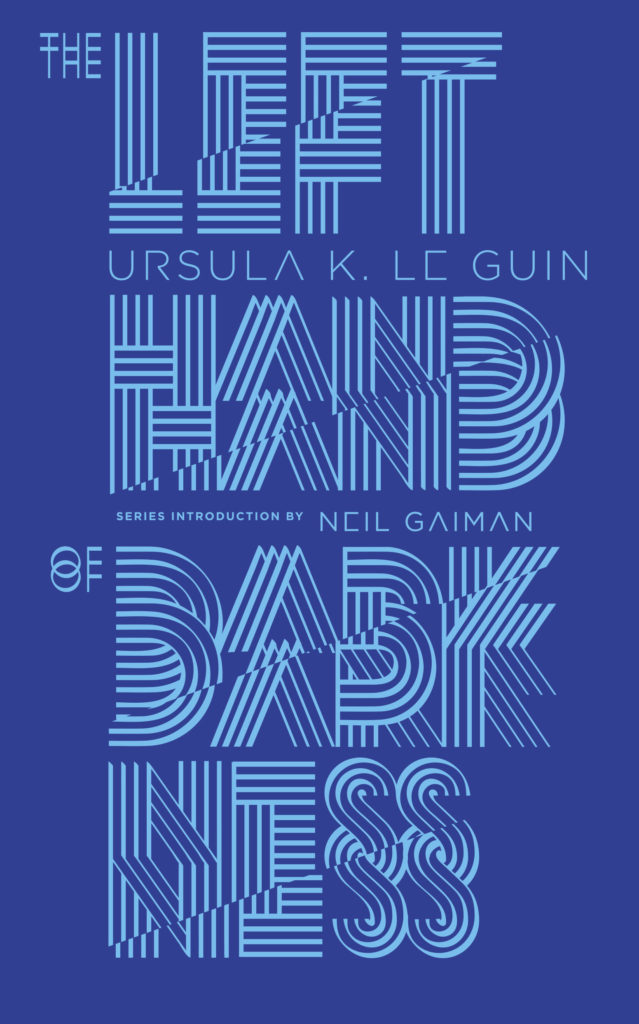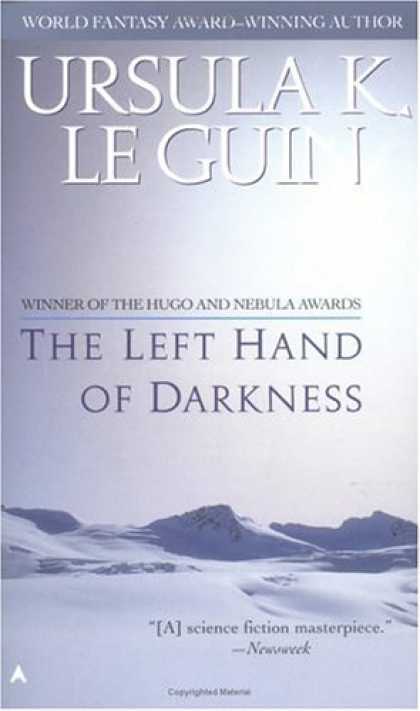This Month On Changing the Map
It’s not often that you pick up a nearly fifty-year-old novel only to find that it mirrors your current political climate with uncanny precision. It’s a bit like hearing a sermon at the precise moment you need it. You’re grateful for the enlightenment, but vaguely unsettled that the good lord or the universe knew you needed it. That’s exactly what happened to me this month as I reread Ursula Le Guin’s classic tale of gender, political intrigue, and xenophobia, The Left Hand of Darkness. The hairs on the back of my neck are still standing up. Let’s jump in.
About the Author
 Ursula Kroeber Le Guin (1929 — present) was raised in Berkeley, California, the daughter of an anthropologist father and a writer mother, a childhood that seems designed to create the kind of poetical novels she’s famous for — deeply realized stories of the Other.
Ursula Kroeber Le Guin (1929 — present) was raised in Berkeley, California, the daughter of an anthropologist father and a writer mother, a childhood that seems designed to create the kind of poetical novels she’s famous for — deeply realized stories of the Other.
Le Guin was a groundbreaker, not just for the subjects she tackled, but for the beauty of her prose and worldbuilding, as well as armfuls of awards she’s received for her work — Hugos (the first for a female writer), Nebulas, Pushcarts, and Pens, to name just a few.
The Left Hand of Darkness was published in 1969, the year of the first lunar landing, and is the fourth novel in Le Guin’s Hainish cycle, which includes her equally famous novel, The Dispossessed.
She has been writing and submitting stories since the age of 11.
 The Left Hand of Darkness (1969. 2016 reprint with forward by Neil Gaiman)
The Left Hand of Darkness (1969. 2016 reprint with forward by Neil Gaiman)
Written by: Ursula K. Le Guin
Genre: Science Fiction
Pages: 255
Publisher: Penguin Books
Spoilers: Everything from start to finish, although I try to be vague on the ending.
The Left Hand of Darkness opens with a science fiction premise that surely must have been on everyone’s mind in 1969: First Contact.
Told as a report back to his home planet, Protagonist Genly Ai, an envoy from an alliance of planets called the Ekumen, is trying to convince the King of Karhide on the newly discovered planet Gethen (known as Winter because of its climate) to join the alliance.
The Ekumen chooses to send a single envoy to newly discovered human-occupied planets — a signal that the Ekumen means them no harm. Vulnerable to Gethen’s extreme cold, confused by their courtly customs of pride and face-keeping called Shifgrethor, we’re sure almost from the beginning of the novel that Genly’s mission is in trouble. One of the King’s councillors, Lord Estraven, tries to warn Genly about the King’s fearful xenophobic patriotism, and how it may dash any hope of Genly’s success. But Genly can’t decide if he trusts Estraven, or any of the strange Gethens, so he doesn’t listen to those warnings.
It’s the unusual Gethen physiology that makes The Left Hand of a Darkness a gender-issue classic. In this universe (and in other books in her Hainish Cycle), all 80-plus planets of the Ekumen have been colonized by the inhabitants of Hain, including our Earth. And on all those planets, the humans are gendered. All except for Gethen.
On Gethen, Genly surmises, the long-dead colonizers experimented, creating a race of beings that are same-sexed for most of the month, and gender-specific for only a few days when they are in Kemmer (a uniquely Gethen form of estrus), their physiology changing only slightly, and really only noticeably if they become pregnant. When they enter Kemmer they can become man or woman, father or mother. When this period of sexuality and fertility is over, they return to their same-sexed — and sexless — state.
At the start of the novel, Genly struggles and is occasionally irritated by the differences between himself and the Gethens. Calling all Gethens “he” for most of the novel, he tries to pin down true Gethen gender based on their traits, movements, and voices, but is frustrated by his attempts. That Genly chooses to think of them as male for most of the novel underscores his own unease in interacting with the same-sex Gethens.
A man wants his virility regarded, a woman wants her femininity appreciated, however indirect and subtle the indications of regard and appreciation. On Winter they will not exist. One is respected and judged only as a human being. It is an appalling experience. (pgs. 77-78)
 It’s only through his relationship with Estraven that Genly comes to understand what it means to be a Gethen. When Estraven pleads Genly’s case for the planet’s inclusion into the Ekumen, he puts his reputation and his life on the line to help his friend. At first Genly mistrusts Estraven, thinking that his mistrust must spring from the strange conversational rituals of Gethen face-keeping. Only when Estraven is banished from the Kindgom does Genly realize how much Estraven had risked for him.
It’s only through his relationship with Estraven that Genly comes to understand what it means to be a Gethen. When Estraven pleads Genly’s case for the planet’s inclusion into the Ekumen, he puts his reputation and his life on the line to help his friend. At first Genly mistrusts Estraven, thinking that his mistrust must spring from the strange conversational rituals of Gethen face-keeping. Only when Estraven is banished from the Kindgom does Genly realize how much Estraven had risked for him.
Though not quite banished himself, Genly is painfully aware that the Karhide King has no interest in joining the Ekumen (and is in fact terrified of the very idea of the existence of other planets). Here the xenophobic attitudes of Gethen’s King will feel painfully close to our own political climate. The King wants no part of open trade and open ideas. He wants only, as he bellows near the ending, “Karhide first, Karhide first!”
Genly decides to make his case with competing kingdom Orgoreyn. At first blush, the bureaucrats and factions of Orgoreyn seem much more interested in joining the Ekumen. Genly relaxes, believing that his mission to guide the planet into the Ekumen will be successful at last. But despite their enthusiasm for both the envoy and the Ekumen, Genly can’t shake the feeling that something is subtly wrong.
Again Estraven, who understands his own people better than Genly could ever hope to, tries to save him from disaster, begging Genly to call down his ship and prove the existence of other planets to the populace before it is too late. Again Genly mistrusts Estraven’s offer of guidance, and wakes up to find himself naked and freezing in the back of truck on the way to a work-camp.
Here the novel shifts from court intrigue and anthropological asides to an epic life or death struggle. After Estraven saves a nearly-dead Genly from the work camp, they attempt a dangerous journey across Gethen’s massive ice fields. Both men are fugitives, but we worry more about the fragile Earther Genly, who even after two years planet-side, is unaccustomed to Gethen’s relentless cold.
But he’s not the only fragile member of the team. Cut off from the suppressant drugs he could have used to avoid going into Kemmer, Estraven enters this period of sexuality time after time during their journey. Watching Estraven struggle silently with his own sexual needs, Genly’s heart opens and he finally realizes the source of his distrust.
And I saw then, and for good, what I had always been afraid to see, and had pretended not to see in him: that he was a woman as well as a man. … What I was left with was, at last, acceptance of him as he was. Until then I had rejected him, refused him his own reality. (p. 209)
Genly embraces his love for his friend, although it remains unconsummated. Le Guin later admitted in interviews that she was quite shy about writing sex scenes at that time in her writing career. This may have colored her decision to focus on the inherent problems of alien sex rather than attempting to portray them.
For us to meet sexually would be for us to meet once more as aliens. We had touched, in the only way would could touch. We left it at that. I do not know if we were right. (p. 210)
Consummated or not, one thing is clear: what develops between Genly and his Gethen protector Estraven is a true love story. One that ends tragically, as the best love stories do.
How it Changed The Map
 Although the novel would still be a gripping read without the gender themes that made it so famous, it’s Le Guin’s examination of our assumption about gender roles that Changed the Map.
Although the novel would still be a gripping read without the gender themes that made it so famous, it’s Le Guin’s examination of our assumption about gender roles that Changed the Map.
Le Guin plays with the concept of intrinsic versus adopted gender traits — the theories of essentialism (women are intrinsically feminine due to biology) and constructivism (feminine traits are learned behaviors cultivated to survive life in a patriarchy.)
Le Guin makes an interesting character choice for this discussion. She gives us male-gendered protagonist Genly, full to the brim with unexamined assumptions about women. For all his wisdom in matters political and anthropological, Genly’s not exactly enlightened when it comes to his views about women. Here he tries to explain women to a curious Estraven.
“Women…. Women tend to eat less … Even where women participate equally with men in the society, they still after all do all the childbearing, and so most of the child rearing…”
“Equality is not the general rule, then? Are they mentally inferior?”
“I don’t know. They don’t often seem to turn up mathematicians, or composers of music, or inventors, or abstract thinkers. But it isn’t that they’re stupid.” (p. 196)
In an interview with the New Yorker from 2009, Le Guin answers the question of whether or not her protagonist, Genly, is sexist.
Oh, yes. Not a mean one. Not a misogynist. He just has accepted and identified with his society’s definition of women as weaker than men, more devious, less courageous, etc. — physically and intellectually inferior. This gender prejudice has existed for so many thousands of years in so many different societies that I had no hesitation in carrying it on into the future.
Unlike her feminist predecessors Charlotte Perkins Gilman or Rokeya Hossain, Le Guin didn’t create a feminist utopia where women can do everything a man can, and better. She doesn’t challenge gender by pretending it doesn’t exist but her characters do urge us to accept a person’s gender as it is, and not as we would wish it to be. Are we really so sure that we know the difference between biology and learned behaviors? And she goes beyond the feminist utopian ideal to quietly posit this: are gender stereotypes and their narrow viewpoints caustic to men as well as women?
Next Month: We jump ahead to Margaret Atwood’s 1985 novel of a theocratic and ecological dystopia, A Handmaid’s Tale, just in time for its premiere in April on Hulu.

No Comments